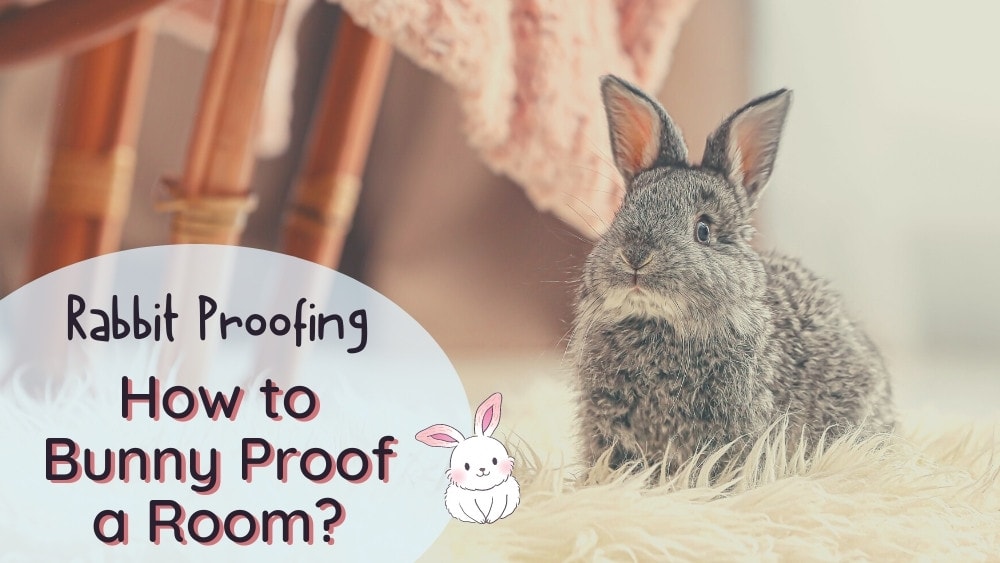As much as I love my free-range rabbit, it’s like letting a toddler run around the house with scissors. Rabbits have a need to gnaw. Their strong, sharp incisors grow about a centimeter a month, and can slice through fabric, plastic, and electrical wires. So, obviously, for the safety of both your rabbit and your property, you should bunny-proof a room before letting your pet run free.
This article will teach you how to properly bunny-proof your home.
What is Rabbit-Proofing?
Rabbit-proofing means protecting your home and your belongings from the chewing, digging, and other natural but potentially destructive habits of rabbits. This involves covering carpets, protecting baseboard, and wrapping cords and furniture legs. You should also remove dangerous plants or chemicals, and close any tight spaces where a bunny could get trapped.
How to Bunny-Proof a Room
In this step-by-step tutorial on how to bunny-proof a room, we’ll walk through an imaginary home together and survey the various risk or problem areas for free-roaming rabbits. We’ll suggest solutions to making those areas safe, then conclude with a shopping list of bunny-proofing supplies. Ready to hop in?
1. Carpets and Flooring
There are multiple issues to consider when we think about safe flooring for rabbits. First is footing. Rabbits need firm, textured footing to feel secure. Many bunnies won’t even venture onto slippery flooring like hardwood or linoleum. This can be helpful if you don’t want your rabbit coming into the kitchen – but if you do, you’ll need to put down a rug or other grippy surface.
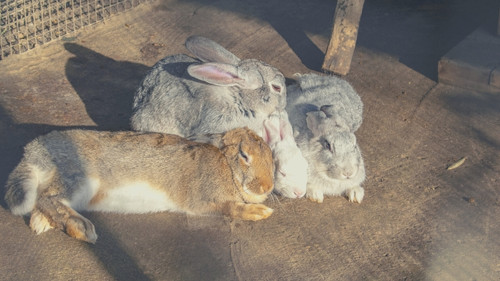
Carpets aren’t safe for rabbits either – and I don’t think this gets talked about enough. It’s inconvenient for many homeowners to keep rabbits off the carpet, but it could save your bunny’s life.
Some bunnies love to chew on carpet – but carpet is usually made from nylon or polyester that a rabbit cannot digest. I have a friend whose bunny tragically passed away after ingesting too much carpet fiber and developing GI stasis as a result.
How Do You Bunny-Proof a Room with Carpet?
Some indoor rabbits leave carpets alone, especially if they live in enriching habitats filled with hiding holes or digging boxes to keep them busy. But if your rabbit seems to be attacking the carpet, first try an apple bitter spray.
Rabbits will usually pick a favorite corner where they repeatedly go after the carpet. Spraying that corner with a foul-tasting spray might convince them to leave it alone. This brand of apple bitters has better reviews than others – but rabbits can be stubborn.

If a deterrent doesn’t work, you’ll have to cover the area with a ceramic tile or a rabbit-safe rug. Rugs made of cotton and jute are safe for rabbits to chew on, as long as they aren’t treated with nasty chemicals. You can also use a plastic office-chair mat, but those pose the same risks as carpet if rabbits chew and ingest the plastic.
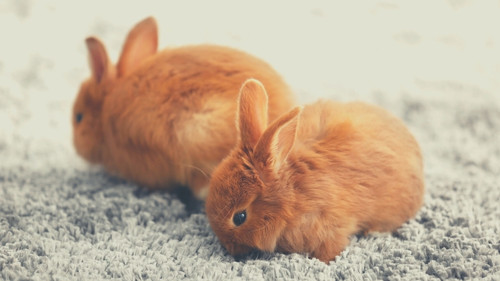
What’s my favorite flooring for rabbits? Interlocking luxury vinyl tile. If you have the option of putting LVT down in your bunny room, go for it! It’s waterproof and provides just enough grip to make bunnies feel comfortable without having loose edges they can gnaw. (Don’t use thin stick-on vinyl tile, as the edges can peel and become chewing hazards.)

2. Baseboard and Trim Molding
Rabbits love to chew baseboards and trim. If your pet stays in a designated rabbit room, you may want to simply replace the baseboard in that room with untreated wood trim that your rabbit can chew safely.
If replacing the trim isn’t an option, you can cover it with a wood plank or “thin stock” hardwood panels. Safe wood for rabbits to chew includes untreated applewood, cherry, and poplar (aspen). Avoid soft pine if you can, and definitely stay away from cedar.
My favorite solution is to lay a long piece of wire closet shelving against the wall and attach it with small hooks, but you can also try using urine guards or cardboard edge protectors.

3. Furniture
Bunnies can hop up on chairs or sofas, so you’ll need to protect the top, feet, and undersides of any furniture within the bunny’s reach.
Let’s start with the underside. Rabbits love to crawl into the safe, dark spaces under couches and tear at the mesh fabric above them. You can prevent this by filling the space under your sofa with storage bins or blankets, or you can take NIC shelving and zip-ties and create a fence around your couch.

You can protect your couch cushions from bunny teeth, claws, and the occasional accident with a slipcover. There are a host of waterproof furniture covers made specifically for pet owners.
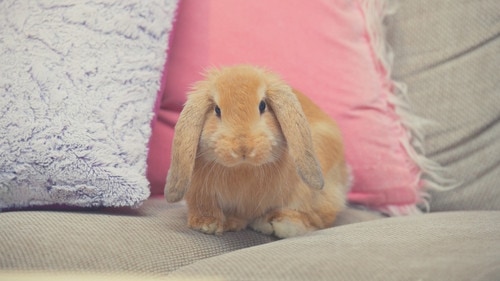
If you can afford it, though, you should consider a 100% cotton cover. Cotton is made of cellulose, which rabbits can digest, so it’s safer than a synthetic option.

And what about furniture legs? Opt for furniture with iron or stainless steel legs, or wrap wooden furniture legs in socks or a strip of cotton towel. Avoid foam or rubber tape; it’s effective, but not safe for bunnies to eat.
4. Electrical Outlets and Wires
The pieces of a severed phone cord could serve as the badge of a long-time bunny owner. It happens to all of us, and it can happen so quickly! A rabbit hopping by your charger will go out of its way to snip the wire in two.
Why? Perhaps bunnies see wires as roots they need to clear out of their burrows. Whatever the reason, it’s definitely not safe for bunnies to bite electrical wires!
You need to cover ALL electrical cords in your home that are 3-feet from the floor or lower. Also make sure to cover ones that a rabbit can reach if it climbs onto a couch.
It’s super easy to pop your wires into split loom plastic tubing. It comes in a variety of widths and the ridges on this tubing deter most bunnies from chewing on it.

In the case of a very determined bunny that will chew through split loom tubing, you can run your wires through a cut garden hose. It’s harder to work with and not very aesthetic, but can hold up even to bunny teeth.
If you have a bundle of wires that converge on the floor, maybe with a surge protector, pop the whole bundle into a tall, attractive basket. Then use a floor cable cover to cover any wires running across the floor.

5. Curtains and Window Blinds
Rabbits will often burrow into floor-length curtains. They not only ruin your curtains, but risk pulling the whole rod down on themselves. If your rabbit is confined to one room, then the long curtains should go. But if you have a whole-house-ranging bunny and prefer to use them, try a bunny tunnel. Sometimes placing a tunnel under and through the curtains will create a satisfactory burrow, and your bunny will leave the curtains alone.

You can also grab some ever-useful “Neat Idea Cube” wire shelves and gate off the area around a curtain.
6. Zones to Block Off
Some areas – like laundry rooms or furnace rooms, for example – just may not be safe for rabbits no matter what you do. There’s nothing wrong with using baby gates or exercise pens to block off hazardous areas or sections of your home that you don’t want to bunny-proof.

Also make sure to fill any small gaps behind furniture or in other areas like closets where rabbits could get stuck. Like rodents, bunnies can squeeze into ridiculously tight spaces.
A word on baby gates: use metal or heavy-gauge wire gates. Rabbits can chew through barriers made of cardboard, wood, and plastic. Also, this may surprise you, but bunnies can climb. I’ve watched them climb up and over wire fencing! So choose a gate with plenty of vertical bars, but not so many horizontal ones that it would make an easy-to-climb mesh.
And, speaking of climbing, you might need to put a gate around your stairs. A self-confident house bunny is fearless.
7. Remove Hazards
Remove anything that might be dangerous or poisonous to bunnies from your rabbit’s environment. Mouse traps, rat or ant bait, small batteries, and cleaning chemicals need to be shut behind baby locks. If you – or your kids – regularly snack on chocolate chips, popcorn, cereal or human foods that are toxic to bunnies, keep the crumbs cleaned off the floor.
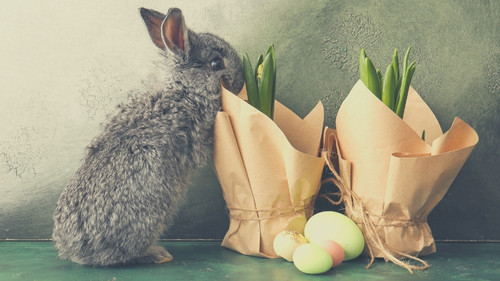
And don’t forget about houseplants! Some extremely common houseplants like snake plant (Sansevieria), sago palm, and oleander are poisonous to rabbits, dogs, and humans if ingested. Place plants on tables or hang them on macrame nets from the ceiling.
How Do I Stop My Rabbit from Being so Destructive?
The final-step in protecting your home from a bunny’s destructive habits is to give your rabbit constructive ways to use its instincts to chew, dig, and burrow. Don’t let your bunny get bored; create a climbing castle out of cardboard boxes. Give him a box full of hay or shredded newspaper to dig and tunnel into. Encourage him to play with rope toys, hardwood sticks, old cotton towels, and cat-scratcher mats.

Make sure your bunny always (always!) has hay to nibble. This will both satisfy his gnawing urge and keep his GI tract happy.
Materials You Need for Bunny-Proofing a Room
Here’s a shopping list of my favorite rabbit-proofing tools. You may not need all of these supplies for bunny-proofing your particular room, but find the items that suit your needs. It might seem like a large expense at first, but compared to replacing flooring or furniture, or extensive veterinary bills, the investment in bunny-proofing is well worth it.
- Jute or cotton rug – for covering large areas.
- Large ceramic tiles – for covering problem-spots on carpets or near trim.
- Closet shelving or NIC wire shelving – for gating off baseboard or furniture.
- Hooks and zip ties – for attaching wire shelving.
- Split loom tubing – for encasing wires.
- Floor conduit – for electrical cords.
- Sofa cover – either synthetic or natural fiber.
- Untreated hardwood boards – for covering molding or other areas.
- Metal baby gate or exercise pen – for blocking off problem areas.
- Litter box and enrichment activities – to keep bunny off your stuff!

A Word of Caution
Make sure the materials you’re using to bunny-proof are bunny-safe. I often see recommendations for covering corners with tape, using synthetic rubber edge protectors, or using polyester rugs. These items may protect your belongings, but they can still cause damage to your bunny’s digestive system
Frequently Asked Questions
Can I let my rabbit free-roam in my room?
Yes, absolutely! If you potty-train your bunny and provide it with a covered area to be its burrow, it will love to run and play in your room. Just make sure your room is bunny-proofed, as we discussed in this how-to article.
How do I keep my rabbit from chewing the walls?
If your rabbit is scratching at the walls or shredding wallpaper, you may need to tell him “no” firmly but gently and redirect him to more constructive activities. Spend time playing with your rabbit, give him a digging box, and make sure it is spayed or neutered to reduce some of the nesting instincts.
How do you bunny-proof corners?
You can bunny-proof corners by placing a ceramic tile on the floor, covering the trim with thin hardwood paneling, and attaching a folded cat scratcher mat to the wall with adhesive strips. Or you could gate off the entire corner with wire shelving laid on its side.
Now You’re Bunny-Proofed and Ready to Roll!
Ideally, bunny-proofing should be done before you introduce your rabbit to its new space. But once you bring Bunny home, you’ll probably need to make some adjustments based on your rabbit’s personality. It may be a tunneler and find how to sneak under the recliner, or maybe it’ll be the stinker that bites your zip-ties in half. As you adapt your bunny-proofing to the rabbit’s needs, you should also use positive reinforcement to encourage it to play in its approved habitat. Over time, you’ll learn to build a safe and effective habitat for your rabbit.
What’s the worst thing your bunny got into? How did you need to bunny-proof in surprising ways? We’d love it if you share your stories in the comments!


